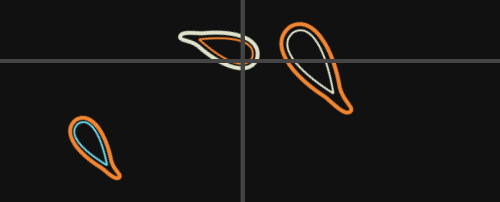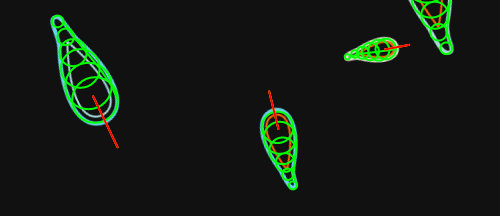Monday, February 17, 2014
New Chrome plugin helps marketers get an amazing 42% reply rate on cold prospecting email@@
Marketing automation company Autopilot is releasing a new prospecting tool for sales and marketing that’s generating up to 42 percent reply rates on cold email tomorrow.
That compares to a traditional rate of just 1 percent to 9 percent.
The tool, which companies like Bosch, Model N, and Voxer are already using, helps marketers get live, current email for people they find on LinkedIn, Facebook, Twitter, Quora, and other popular sites online. Called Prospect Ace, the plugin bridges the seemingly inevitable gap between marketing and sales.haeSharkey told me last week. “We saw huge ga
The Chrome plugin focuses on solving that data problem in the prospecting stage: finding people who might be interested in your product or service. Once you’ve found someone that looks like they might be a potential buyer, Prospect Ace initiates a query in Autopilot’s data and modeling system and spits out an email, which Sharkey says is “guaranteed to be verified.”
“Prospect Ace integrates into Autopilot,” Sharkey says. “Just pick a campaign, drop the prospect right into the campaign, and he’s now in my automated marketing campaign.”
While Bosch is the biggest customer whose name is public for Prospect Ace, Sharkey told me several other names that would raise a few eyebrows, including two of the biggest names in file-sharing and cloud-content management and one of the biggest mobile carriers in the U.S.
And the company is eating its own dogfood, too.
“When we came back in Q1, we decided we would only build our pipeline using this tool,” Sharkey said. “We’ve already closed a heck of a lot of business off this already.”
That includes prospecting success which has hit 42 percent.
Aaron Ross, the former director of sales for Salesforce and now a consultant and author of Predictable Revenue, agrees.
“An important part of prospecting is about the quality of the data,” Ross said in a statement. “Prospect Ace is the first data solution to allow sales development to easily target prospect and find verified email addresses from social profiles.”
That is, of course, the big difference.
The alternative is buying data from Data.com or other sources, and that can be tricky — analytics firm KISSmetrics once asked for a refund after finding its purchased data to be 80 percent inaccurate. Sharkey says that Prospect Ace simply provides better data, which, when used appropriately, generates much better returns.
Pricing ranges from $199/month and up.
The Pond – building a multi-platform HTML5 game@@
Introducing The Pond
The Pond is a multi-platform HTML5 game (source code) that explores minimalistic design and resolution independent gameplay. The Pond isn’t about reaching a high score, or about buying weapon upgrades. It’s about relaxing and exploring a beautiful world.
It is available on all these platforms/in all these stores:
In making The Pond I came across many performance obstacles which I will explore in detail (especially when optimizing the codebase for mobile).
Tools
Before I begin, I would like to mention the two tools that made coding The Pond both efficient and highly enjoyable: Light Table and CocoonJS.
Light Table is an IDE (still in alpha) which provides an integrated development environment for real-time javascript code injection. This means that javascript edited within the editor can be previewed without reloading the page. If we look at the shape of the fish in the game we notice that it is comprised of Bézier curves. Instead of trying to find an editor for creating Bézier curves, I simply estimated a basic shape and modified the variables in real-time until I was satisfied with it’s look and feel.
CocoonJS on the otherhand provides a canvas optimized compatibility layer for improved performance on mobile devices. Not only does it optimize, it also provides an interface for exporting our application to many devices (Android, iOS, Amazon (android), Pokki, and Chrome Web Store).
Physics
The Pond may seem simple on the outside, but on the inside it’s full of performance optimizations and responsive features. As we resize the game, it updates and re-optimizes itself to render less objects and spawn less fish, and if that’s not enough the framerate degrades smoothly to keep physics in check. This is thanks to the use of a fixed interval physics time step.Gameprogrammingpatterns.com provides a good explanation for how to do this and why it matters, but honestly the code makes the most sense:
var MS_PER_UPDATE = 18; // Time between physics calculations var lag = 0.0; // accumulate lag over frames var previousTime = 0.0; // used for calculating the time delta // main game loop function draw(time) { requestAnimFrame(draw); // immidiately queue another frame lag += time - previousTime; // add time delta previousTime = time; var MAX_CYCLES = 18; // prevent infinite looping/hanging on slow machines // physics calculations while(lag >= MS_PER_UPDATE && MAX_CYCLES) { // user input, movement, and animation calculations physics(); lag -= MS_PER_UPDATE; MAX_CYCLES--; } // if we exhausted our cycles, the client must be lagging if(MAX_CYCLES === 0) { // adaptive quality lowerQuality(); } // if 5 frames behind after update, jump // this prevents an infinite input lag from ocurring if(lag/MS_PER_UPDATE > 75) { lag = 0.0; } // draw to canvas paint(); } |
What’s important to notice here is that physics is not calculated based on the time delta, instead it’s calculated at a fixed 18ms interval. This is important because it means that any client lag will not be reflected in physics calculations, and that slower machines will simply lose framerate.
Dynamic Quality
The next optimization we notice is the
lowerQuality() function, which adaptively decreases the render quality of the game. The way this works is simply by re-sizing the drawing canvas (it’s still full screen, it simply gets streched out), which in-turn leads to reduced spawns and collisions.function resizeWindow() { // quality is a global variable, updated by lowerQuality() $canv.width = window.innerWidth * quality/10 $canv.height = window.innerHeight * quality/10 ctx = $canv.getContext('2d') ctx.lineJoin = 'round' // resize HUD elements, and reduce spawning if(GAME.state === 'playing') { GAME.spawner.resize($canv.width, $canv.height) GAME.levelBar.resize($canv.width, $canv.height) GAME.levelBalls.resize($canv.width, $canv.height) } else { if(ASSETS.loaded) drawMenu() } } |
Spawning
Now, we’ve been talking about reducing spawning to improve performance so let me explain how that happens. The spawning algorithm works by creating a virtual grid sized based on the window size. As the player travels from one grid zone to another, the adjacent zones are populated with enemies:

Spawner.prototype.spawn = function(zone) { // spawn 1-3 fish per 500sqpx, maybe larger maybe smaller than player // 0.5 chance that it will be bigger/smaller var mult = this.width*this.height/(500*500) for(var i=0, l=(Math.floor(Math.random()*3) + 1) * mult; i < l; i++) { // spawn coordinates random within a zone var x = zone[0]+Math.floor(this.width*Math.random()) - this.width/2 var y = zone[1]+Math.floor(this.height*Math.random()) - this.height/2 var size = Math.random() > 0.5 ? this.player.size + Math.floor(Math.random() * 10) : this.player.size - Math.floor(Math.random() * 10) // spawn a new fish var fish = new Fish(true, x, y, size, Math.random()*Math.PI*2-Math.PI, Math.random()*Math.PI) this.fishes.push(fish) } return zone } |
The last piece of the puzzle is removing enemies as they move far enough away:
// if far enough away from player, remove if(distance(fish, player) > Math.max($canv.width, $canv.height) * 2) { fish.dead = true } |
Collisions
The next performance optimization lies with the collision code. Colliding irregularly shaped objects can be extremely difficult and resource intensive. One option is to do color based collision (scan for overlapping colors), but that is much too slow. Another option might be to mathematically calculate Bézier curve collisions, however this is not only CPU intensive, it is also quite difficult to code. I finally opted for an approximation approach using circles. Basically I calculate the position of circles within each fish and detect circle collision among the fish. Boolean circle collision is extremely efficient, as it simply requires measuring the distance between objects. This ends up looking like this (debug mode):

Fish.prototype.collide = function (fish) { // the fish has been killed and is being removed or it is far away if (this.dying || fish.dying || distance(this, fish) > this.size * 5 + fish.size*5) { return false } // there are 6 circles that make up the collision box of each fish var c1, c2 for (var i=-1, l = this.circles.length; ++i < l;) { c1 = this.circles[i] for (var j=-1, n = fish.circles.length; ++j < n;) { c2 = fish.circles[j] // check if they touch if(distance(c1, c2) <= c2.r + c1.r) { return true } } } return false } |
We also avoid unnecessary collision calculations by only checking the fish that are visible (or near-visible):
if(Math.abs(fish2.x - player.x) < $canv.width && Math.abs(fish2.y - player.y) < $canv.height) { // check } |
Drawing
After getting the physics+ out of the way, it’s time to optimize drawing operations. Many games use sprite maps for animation (Senshi for example) which can be highly optimized. Unfortunately our fish are dynamically generated so we must find other ways to optimizing drawing. First lets use Chrome’s javascript profiler to identify bottlenecks:

What we see here is that
stroke is using a lot of resources. Truth be told,fill used to be there too. This is because both were called heavily when drawing fish. The game looked a bit like this:
After removing
fill I saw a huge performance increase, and the game looked much better. The reason the drawImage function is up there as well is because I take advantage of offscreen canvas rendering. Each fish is drawn on its own offscreen canvas which is then rendered onto the larger visible canvas. This is also what allowed me to easily explode the fish into particles by reading pixel data:Fish.prototype.toParticles = function(target) { var particles = [] // read canvas pixel data var pixels = this.ctx.getImageData(0,0,this.canv.width, this.canv.height).data for(var i = 0; i < pixels.length; i += 36 * Math.ceil(this.size/20) * (isMobile ? 6 : 1)) { var r = pixels[i] var g = pixels[i + 1] var b = pixels[i + 2] // black pixel - no data if(!r && !g && !b){ continue } // Math to calculate position var x = i/4 % this.canv.width - (this.canv.width/2 + this.size) var y = Math.floor(i/4 / this.canv.width) - (this.canv.height/2) var relativePos = rot(x, y, this.dir) x=this.x + relativePos[0] y=this.y + relativePos[1] var col = new Color(r, g, b) var dir = directionTowards({x: x, y: y}, this) particles.push(new Particle(x, y, col, target, Math.PI*Math.random()*2 - Math.PI, this.size/20)) } return particles } |
The End
In the end the performance optimizations paid off and made the game feel more polished and playable even on lower-end mobile devices.
If you enjoyed this post, I regularly blog about my development projects over athttp://zolmeister.com.
The Pond awaits exploring…
Subscribe to:
Comments (Atom)





